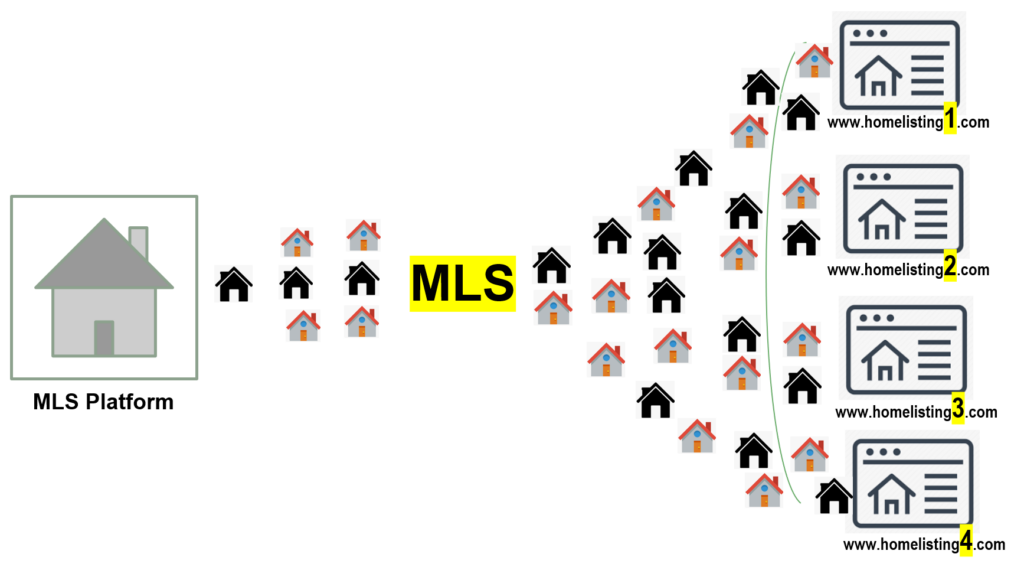In real estate, two primary types of platforms serve as hubs for property listings: MLS (Multiple Listing Service) and public real estate platforms. While both systems provide buyers, sellers, and agents access to property listings, they differ significantly in their purpose, accessibility, accuracy, and functionality. Understanding the distinctions between MLS and public real estate platforms is crucial for anyone navigating the real estate market, whether you’re an agent, a potential homebuyer, or a seller.
This article will explore how MLS systems differ from public real estate platforms, highlighting key aspects such as their structure, access, listing accuracy, and impact on the buying and selling process.
What is an MLS?

An MLS, or Multiple Listing Service, is a network of databases licensed real estate professionals use to share information about properties for sale. An MLS aims to facilitate cooperation and collaboration among real estate brokers and agents, allowing them to access and share property listings. In most MLS systems, properties are listed by brokers or agents who represent sellers, and other agents within the system can view and show those properties to potential buyers.
MLS systems are regional, typically covering specific geographic areas, such as a city or a particular state. Each MLS is operated independently, although some MLS networks may have regional or national affiliations to increase property exposure.
Key Features of MLS Listings
- Access to detailed, accurate property information.
- Listings are available only to licensed real estate professionals, although some MLS systems allow limited consumer access.
- Detailed property data, including photos, descriptions, pricing, and history.
- Regular updates and verification of information to ensure accuracy.
- Collaboration between agents to ensure wider exposure for properties listed on the MLS.
What are Public Real Estate Platforms?
Public real estate platforms are websites or online portals that aggregate property listings for a broad audience of potential buyers and sellers. These platforms include sites like Zillow, Realtor.com, Redfin, and Trulia. Unlike MLS systems, which are designed for professional use, public real estate platforms are accessible to the general public. Buyers, sellers, and real estate agents can freely browse these platforms to find listings, conduct research, and even connect with agents.
Public platforms often pull data from MLS databases, but they can also include non-MLS listings, such as privately listed by owners (FSBO—For Sale by Owner) or off-market properties. These platforms are designed to attract a wider audience, with user-friendly interfaces and features to simplify the property search process.
Key Features of Public Real Estate Platforms
- Open to the general public, including buyers and sellers.
- Aggregates MLS data, FSBO listings, off-market properties, and new construction.
- Allows users to search and filter properties based on various criteria (e.g., price, location, amenities).
- Additional tools and resources include home value estimators, mortgage calculators, and neighborhood insights.
- Offers consumer-focused content, such as articles, guides, and market trends.
Key Differences Between MLS and Public Real Estate Platforms
While MLS systems and public real estate platforms serve similar goals—connecting buyers and sellers—they operate in distinct ways. Below, we’ll explore the key differences between these two platforms in several important areas: access, listing accuracy, exposure, and user experience.
Access and Audience
MLS Access
MLS systems are primarily designed for licensed real estate professionals, such as brokers, agents, and appraisers. An agent or broker must pay for a subscription to access MLS data, which grants them permission to view, list, and manage properties within that specific MLS network. These platforms are not open to the general public, though some MLS systems allow limited consumer access through public-facing portals. However, this access is often more restricted than what can be found on public platforms.
Because MLS listings are intended for professional use, their primary audience is real estate agents and brokers who need up-to-date, comprehensive property data to assist their clients. Buyers typically need to work with an agent with access to the MLS system to view MLS-listed properties, though there are exceptions where individual consumers may get some access.
Public Platform Access
Public real estate platforms, in contrast, are open to everyone. Whether you are a first-time homebuyer, an investor, or just browsing for homes, you can freely access these platforms and search for properties. Public platforms are designed to attract a broad audience, so they focus on being user-friendly and providing features that cater to consumers without requiring a real estate agent.
On these platforms, users can browse listings and access valuable resources like home-buying guides, mortgage calculators, and market trends. Many public platforms also allow users to contact agents directly or schedule showings, often providing a seamless connection between potential buyers and real estate professionals.
Listing Accuracy and Information
MLS Listings
One of the main advantages of MLS listings is their accuracy and reliability. Since real estate professionals manage MLS platforms, there is a strong emphasis on ensuring the correctness and completeness of property information. Agents must input detailed information about each listing, including square footage, the number of bedrooms, property features, and listing history. MLS systems typically have rigorous rules and verification processes to ensure all listed information is accurate and up-to-date.
In addition, MLS systems often include detailed data that might not appear on public platforms, such as the property’s previous sale prices, days on the market, and other relevant history. This makes MLS listings a trusted source of information for real estate professionals and their clients.
Public Platform Listings
While still relying on MLS data, public platforms can sometimes feature less reliable information. This is because these platforms may pull data from a variety of sources, including MLS, FSBO listings, and even agent- or seller-uploaded information. While MLS listings typically undergo professional scrutiny, public platforms may host listings that have not been verified thoroughly. For example, FSBO listings might not include accurate pricing or property details since the owner handles the sale without professional help.
Another potential issue with public platforms is the frequency of updates. Listings on these sites may not be as up-to-date as those on the MLS, especially if the data is being aggregated from multiple sources. Although public platforms strive for accuracy, there can be a lag in removing no longer available properties or in making corrections to outdated information.
Exposure and Marketing
MLS Exposure
The exposure of a property listed on the MLS is typically limited to the agent network within that MLS system, which includes licensed brokers and agents. While this ensures that properties receive significant attention from other professionals, it may not provide the same level of exposure to the general public. MLS listings are often syndicated to third-party sites like Realtor.com, Zillow, or Redfin, but the visibility may be somewhat restricted based on the MLS rules.
For example, some MLS platforms may allow properties to be listed exclusively to agents for some time before making them public. This strategy, known as an “office-exclusive” listing, limits exposure to a smaller pool of buyers. It is typically used in high-demand markets where sellers want to test the waters before listing their properties broadly.
Public Platform Exposure
Public real estate platforms provide much broader exposure to both consumers and professionals. Since these platforms are designed for the general public, they aim to attract as many viewers as possible. Properties listed on public platforms often appear on multiple websites, social media feeds, and mobile apps, allowing sellers to reach a wide audience. In addition, public platforms feature interactive tools and features like virtual tours, floor plans, and neighborhood insights, further enhancing the listing’s appeal.
Because public platforms are open to anyone, buyers can easily find and browse listings without the need to engage with a real estate agent. This level of exposure can benefit sellers by attracting a larger pool of potential buyers.
Functionality and Tools
MLS Functionality
MLS systems are tailored for real estate professionals, offering them advanced search functions and tools for listing management. These platforms allow agents to filter properties based on numerous criteria, such as price, location, square footage, and property type. In addition to standard listings, MLS systems often provide tools for tracking market trends, managing offers, and communicating with clients.
Some MLS systems also include built-in features for managing transactions, such as forms for submitting offers, organizing contracts, and handling other paperwork. These features help streamline agents’ and their clients’ buying and selling processes.
Public Platform Functionality
Public real estate platforms are designed to make home-buying accessible to anyone, regardless of their experience level. As a result, these platforms prioritize user-friendly functionality and provide tools that appeal to consumers rather than real estate professionals. Public platforms often include easy-to-use search filters, property comparison tools, mortgage calculators, and the ability to save favorite listings for future reference.
Many public platforms also provide neighborhood insights, school ratings, and price trend analysis, helping consumers make informed decisions about potential homes. These platforms are generally more focused on creating a smooth, self-guided user experience rather than providing advanced tools for industry professionals.
Conclusion
In summary, MLS systems and public real estate platforms serve different purposes in the real estate ecosystem. MLS systems are a powerful tool for real estate professionals, offering accurate and up-to-date listings with in-depth information and greater reliability. While MLS listings are typically more accurate and targeted at agents, public platforms aim to broaden the market reach, providing easy access, user-friendly features, and broader exposure for buyers and sellers.
The choice between MLS and public platforms largely depends on your role in the market. An MLS is an essential resource for managing listings and collaborating with other professionals if you are a licensed agent. If you are a homebuyer, seller, or investor, public platforms provide valuable resources for easily exploring properties, gathering information, and navigating the real estate market. Both systems have their advantages, but when used in tandem, they offer a comprehensive solution for all parties involved in the real estate transaction process.










